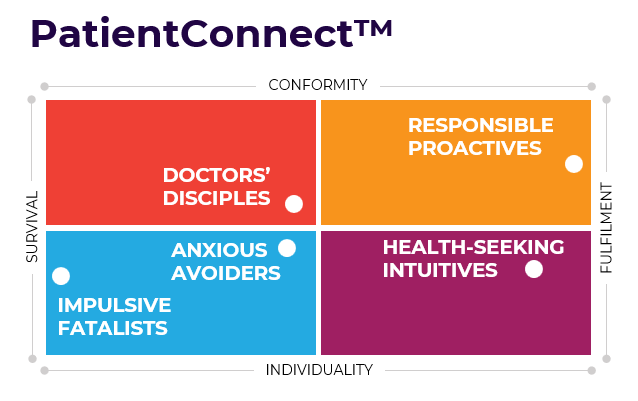What is PatientConnect?
ARTICLE
BY AHSAN SADIQ
This is why PatientConnect is built on a foundation of Social Values: the fundamental attitudes and motivations that form the basis of patients’ healthcare decisions.
By understanding the Social Values of patients across Canada, PatientConnect is able to identify natural target audiences as well as likely skeptical audiences, building effective communication strategies for specific treatments, therapies, and devices.
What motivated Environics to develop PatientConnect?
Today, we live in an expectation economy where consumers are served up targeted messaging and advertisements designed to resonate with who they are.
More and more, this trend has also been applied to healthcare. As patients have seen an increase in the number of healthcare options available to them, organizations have needed to find new ways to become more patient-centric with their approaches – engaging the right patients, at the right time, with the right message.
To understand patient outlooks, organizations need to go beyond demographic and socioeconomic factors and also beyond characteristics associated with particular conditions. Instead, they need to take patient-centric approaches that focus on how healthcare decisions are guided by patients’ underlying mindsets.
This is where PatientConnect comes in.
How did we develop PatientConnect?
Environics Research has been measuring social values since 1983, steadily compiling the largest database of Social Values constructs and trends in North America. Our annual surveys of more than 10,000 Canadians and Americans allow us to precisely track changes in social values over time. Drawing on our total data set also lets us gain deeper insight into specific topics and into the motivations and worldviews of particular groups.
Social Values (psychographics) are an individual’s fundamental motivations that shape the way they see the world, react to situations, and make decisions.
The Environics Research Social Values measurement system identifies the prevalence of different social values in society and monitors changes in people’s values over time. Simply put, social values are key concepts – such as duty, patriarchy, or creativity – that a person either embraces or rejects. They represent a person’s priorities and motivations, as well as their most strongly held beliefs. Together, social values establish a person’s orientation to life and their way of being in the world. Values shape lifestyle choices and aspirations for the future. And they set the context for people’s reactions to situations, people, events, opportunities, and challenges in their roles as consumers, employees, investors, and citizens.
Linking this understanding of Social Values with health-related attitudes and behaviours is the basis of PatientConnect and its five distinct patient segments.
Understanding the Social Values map: What are the five segments?

Our Social Values framework plots trends on two axes: Conformity & Individuality (the y-axis) and Survival & Fulfillment (the x-axis).
Individuals who fall toward the Conformity side of the y-axis tend to go with the status quo. Their reasoning is along the lines of, “If another person has diabetes, like me, and they’ve used a treatment successfully, the same treatment should probably work for me.”
Individuals who fall toward the Individuality side of the map tend to think believe their health issues are more unique or more nuanced. (“Just because a treatment worked for them doesn’t mean it’s going to work for me.”)
People whose values place them on the right side of the map, toward Fulfilment, have the sense that life can be very fulfilling – and a desire to pursue that fulfilment. It’s not just about kind of living to the next day, but about thinking far into the future: defining your hopes, dreams, and aspirations. When these people think about healthcare decisions, they are often thinking about how they will affect their future.
By contrast, those who fall further to the left slide of the map (Survival) tend to see outcomes on a more short-term basis. They tend to be more overwhelmed by thinking about the future, seeing their lives as largely outside their own control.
These four mindsets combine in various ways, enabling us to identify five distinct patient mindsets (in Canada) in the four-quadrant map:
- Doctor’s Disciples
- Responsible Proactives
- Health-Seeking Intuitives
- Impulsive Fatalists
- Anxious Avoiders
Applying the PatientConnect framework: How can you use it?
By leveraging insights from PatientConnect and integrating our segmentation tool into your customer experience research, you are able to better position programs for the intended audience and adapt where necessary to prioritize key Social Values segments. Understanding how patients fit into the PatientConnect segmentation system helps organizations tailor their language, tone and communication channels. This in turn can help organizations achieve better responses, increased engagement, and a generally more differentiated and more relevant customer experience.
Find out how our Health and Wellness team can help your organization
Related insights



Toronto
366 Adelaide Street West
Suite 101, Toronto, ON
Canada M5V 1R9
416 920 9010
Ottawa
116 Albert St
Suite 300, Ottawa, ON
Canada K1P 5G3
613 230 5089
Calgary
421 7th Ave SW
Suite 3000, Calgary, AB
Canada T2P 4K9
403 613 5735
